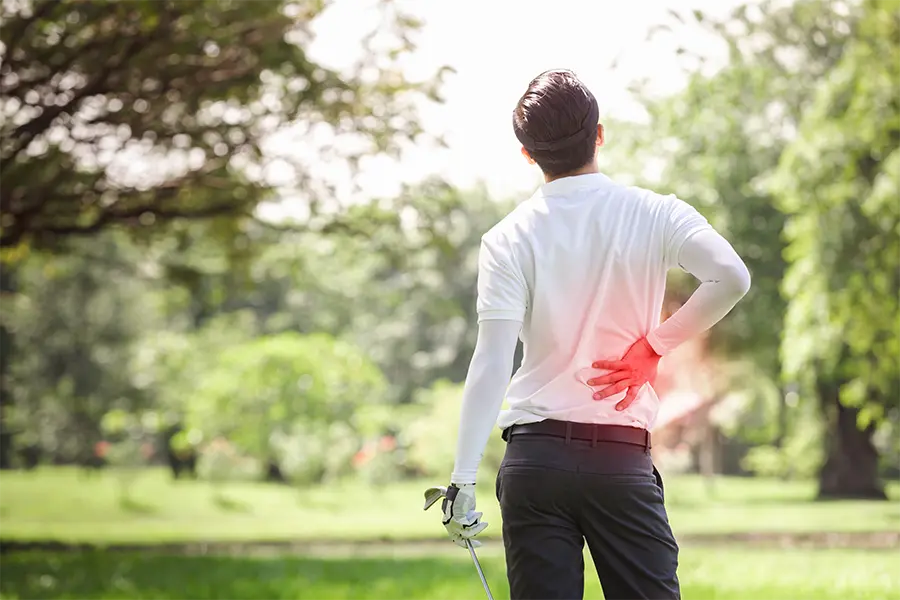
Preventing Common Golf Injuries
Golf is more than a game; it’s a lifestyle. But for many middle-aged men, golf injuries like low back pain, golfer’s elbow, and rotator cuff strain can get in the way of enjoying the sport. Understanding the most common golf injuries, why they happen, and how to prevent them will help you stay healthy and enjoy your time on the course.
In this blog, you will learn:
- The most common golf injuries
- Why these injuries occur on the green
- How to prevent golf-related pain and stay on the course longer
Why Middle-Aged Men Are Prone to Golf Injuries
Many still ask, “Is golf a sport?” This kind of categorization of golf as simply a hobby or weekend activity causes many people to overlook the physical component of the sport. Overall, golfers seriously underestimate the physical demands that golf takes on the body and tend to overlook the prep work. Many injuries are the result of poor warm-up and can be devastating to the player. Most of the time, golfers pull up to tee time without much prep or warmup. This can unfortunately lead to severe injuries, including overuse injuries.
Even worse, these players also golf through the pain and will ignore the warning signs. I always tell my patients that pain is a warning sign from the body that something is wrong. Never play through moderate to severe pain and get it checked as soon as you can. Having pain after a round of golf is fairly normal. If the pain is persistent, it might be a sign that something bigger is wrong.
Many players have a weekend warrior mindset when it comes to golf, which can lead to pain and injury. Consistent conditioning leads to a better golf game and more fun!
Common Golf Injuries and How to Avoid Them
Lower Back Pain in Golfers
Many golfers experience low back pain when they are on the green. This is caused by lack of flexibility, no warm up, and a lack of core strength. It is very common because you have to engage with repetitive twisting while swinging and you are using muscles that you usually don’t use in regular activities. You can combat back pain on the golf course through strength and mobility exercises, especially core strengthening activities. You should also participate in strength training for your legs and arms too, as those are often overlooked. For lumbar and hip mobility, a quick test is to squat to the ground with your heels flat on the floor to assess your flexibility.
Preventing Golfer’s Elbow
Golfers might also experience elbow tendonitis by gripping the club too tightly or from overuse of muscles. It can also occur from hitting the ground and turf repeatedly to take divot. Both medial and lateral pain show up in golfers because the mechanics of swinging a golf club on the elbow leads to strain and pain along the ligaments that support that joint. To combat golfer’s elbow or tennis elbow, it is important to rest and seek treatment if your body is telling you something is wrong. Some different treatments that your physician might recommend include:
- Ice or heat
- Oral NSAIDs
- Elbow exercises or splits
- Steroid injections
- PRP therapy
Rotator Cuff Injuries for Golfers
Rotator cuff injuries are also a very common for golfers, and can be caused by overswinging or from weak stabilizing muscles. Poor shoulder mobility is often linked to pain, which shows the importance of scapular control. The stronger the muscles that secure your shoulder joint, the more protection you have from injury.
Golf Wrist Injuries
Wrist injuries in golfers commonly occur from hitting the ball on rough or unpredictable terrain on the course, like the hard ground, rocks, and tree roots. It can also commonly occur from making bad contact with the golf club or weak wrists. A common diagnosis for this kind of injury is sprains and tendinitis. You should seek an evaluation for this injury if the pain is prolonged and recurring even after 4-6 weeks of rest, ice and heat, and oral NSAID’s. If your pain is severe to the point that you are unable to use the hand, avoiding medical attention could result in fracturing the bones of your hand.
How to Prevent Knee and Ankle Pain
Knee and ankle pain is often caused from using rotational force during your swing and bad stances that you might have on a side hill or bunker. It could also be caused and accelerated through pre-existing arthritis or meniscus issues made worse by carrying clubs or golf bags long distances without rest. You can prevent this pain by strengthening the knee and ankles through exercises specific for these joints.
Proven Tips to Prevent Golf Injuries
There are plenty of preventative measures that you can take to help alleviate the pain you might experience from golfing and prevent injuries. Some ways to prevent golf injuries include:
- Participating in warm-up routines tailored for golfers, especially those that target the arms, shoulders, hips, knees, and lower back.
- Regular core strengthening and flexibility: Daily to weekly in the gym and at home
- Getting your swing analyzed by a professional athletic trainer to determine where you might be overcompensating.
- Being seen by a physical therapist to help focus on strengthening areas of weakness and pain.
Remember to listen to your body on and off the golf course. Here are three signs you shouldn’t ignore:
- Repetitive soreness with certain movements in same areas
- Any tingling, numbness, and weakness could signal nerve impact
- Severe pain following trauma – such as hitting the ground, falling, or missteps
When to See a Specialist
You should seek a specialist’s help if you are experiencing moderate to severe pain that lasts more than a week or keeps getting worse. You should also seek help if your golf injuries cause you to have limited range of motion or start to impact your daily life. A spine or sports medicine doctor can be very beneficial for long-term performance to prevent injuries, improve golf performance, and make golf fun again!
Golf is hard enough with the mental and physical challenges of the course. Don’t add disability and chronic pain to your list of challenges! If you are experiencing any of the above symptoms, schedule a consultation with a golf expert (or golf doc). Don’t let pain ruin your golf game.
Topics covered
About the Author
Featured Resources
Insights to Achieve a Pain-Free Life



